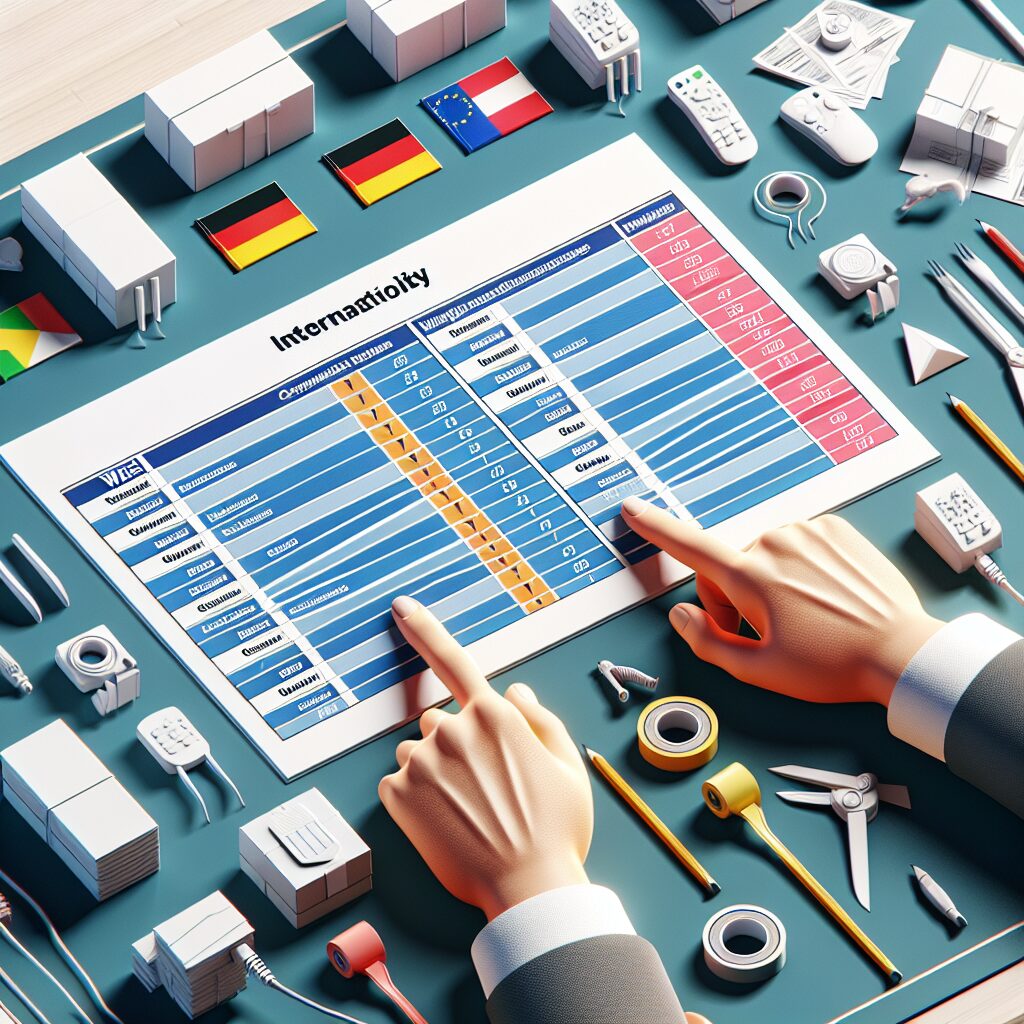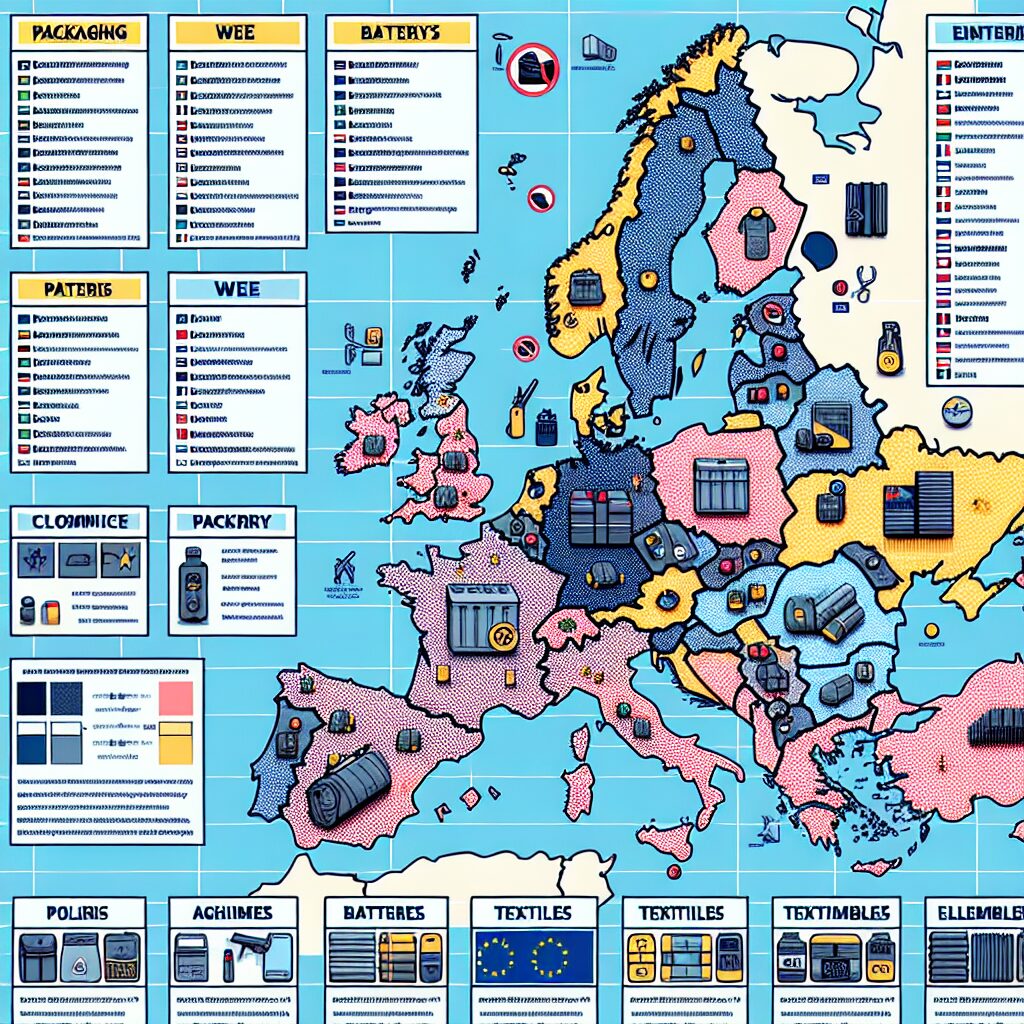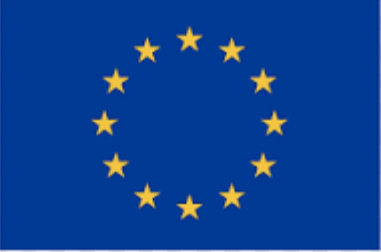About eldris
epr.eldris.ai leads the EPR sector, in fast, automated, AI Agent EU packaging, WEEE, and Battery Compliance for Brands, E-Commerce and Service based businesses expanding into the EU.
In This Article
- Register with national EPR authorities like LUCID (Germany) or CITEO (France) before selling packaged goods.
- Each EU country enforces distinct packaging registration, labelling, and fee obligations under EPR Packaging Regulations.
- Future EU reforms under PPWR will standardise compliance—prepare early by improving traceability and recyclability content now.
- E-commerce platforms such as Amazon proactively enforce EPR compliance policies on sellers.
- Use technology to track legislative changes, deadlines, and submissions across jurisdictions efficiently.
Understanding EPR Packaging Obligations Across Europe
The Landscape of EU EPR Rules
The Extended Producer Responsibility (EPR) Packaging Regulations are transforming how packaging waste is managed throughout Europe. Under these rules, producers are financially and operationally responsible for the entire lifecycle of the packaging they place on the market. These regulations aim to shift the costs of waste management from consumers and public authorities to producers themselves. As a result, stakeholders in manufacturing, ecommerce, and retail must align with country-specific frameworks within the European Union. Navigating this maze of national legislation can be complex, but understanding local EPR laws is vital for staying compliant and avoiding penalties.
Historically, packaging waste collection and recycling obligations were handled by municipalities or third-party organisations. However, the evolution of EPR Packaging Regulations has disrupted that model. Now, producers are accountable for registration, labelling, material reporting, and financial contributions for recycling schemes. What makes this especially challenging is the lack of a unified EU-wide framework; instead, each country enforces slightly different mandates, definitions, and deadlines. This variability leads to legal uncertainty and increased administrative burden for businesses operating cross-border.
The European Commission’s Packaging and Packaging Waste Directive (94/62/EC) sets overarching goals but grants each member state discretion in its implementation. As such, Germany’s policy on dual systems and France’s focus on eco-design diverge significantly, while Italy and Spain have their own unique reporting intricacies. If you’re selling into multiple European countries, understanding local interpretation and execution of EPR Packaging Regulations is crucial. Learn more about EU Packaging & EPR Compliance Guides

Germany’s EPR Regulations for 2025
LUCID Registration and Dual Systems
Germany enforces some of the strictest EPR Packaging Regulations in Europe, with robust infrastructure already in place via the Verpackungsgesetz (Packaging Act). Under German law, any company introducing packaging to the German market must register with the Central Packaging Register (Zentrale Stelle Verpackungsregister, or ZSVR) through the LUCID system before placing any packaged goods on shelves or online platforms.
The registration with LUCID requires detailed company and packaging information, including material types, volumes, and EPR scheme affiliation. Businesses are then obliged to enrol with a dual system—a licensed third-party organisation authorised to handle recycling compliance on behalf of producers. Common dual systems include Der Grüne Punkt, BellandVision, and Interseroh, among others.
Germany also requires producers to file volume declarations, often quarterly or annually depending on turnover and packaging volume. These filings must match the data submitted to both the LUCID register and the dual system. Discrepancies can trigger audits or fines. Moreover, 2025 will see new amendments mandating QR code-based recyclability information and expanded producer definitions, including marketplaces hosting third-party sellers. Read a related article
“In Germany, failing to register in the LUCID system can result in sales bans and fines up to €200,000. Transparency is not optional—it’s legally enforced.”
France’s Eco-Design & Labelling Requirements
France has taken a leadership role in expanding EPR Packaging Regulations to include eco-modulation, a financial mechanism designed to reward or penalise producers based on the environmental performance of their packaging. This approach directly links eco-design practices to fees: for instance, recyclable mono-materials incur lower charges, while non-recyclable or multi-layered packaging types face financial penalties.
Since the AGEC Law came into effect, producers must also include the Triman logo and sort instruction icons on all consumer packaging sold in France. These requirements apply regardless of where the product originates, stressing the urgency of compliance for cross-border sellers. The French EPR system is coordinated through agencies like CITEO, which oversees packaging declarations, reporting, and updates on labelling rules.
France further mandates annual reporting on packaging composition, tonnage, and recyclability via the PRO (Producteur Responsables d’Emballages). Failure to comply may result in financial penalties, public naming, or withdrawal of licences. Companies must also anticipate changes on ‘compostable’ claims and detailed digital interfaces displaying sustainability scores at point-of-sale.
Italy’s EPR Reporting and Membership Process
Italy operates under the CONAI system (Consorzio Nazionale Imballaggi), which coordinates packaging compliance through six material-specific consortia. These include COMIECO for paper, COREPLA for plastic, and other dedicated divisions for metal, glass, wood, and composite materials. Upon market entry, producers must register with CONAI and the relevant supply chain consortium based on their packaging type.
Italian EPR Packaging Regulations require companies to declare the types and weights of materials introduced to the market. This occurs through a structured calendar with deadlines that vary by sector and company size. Moreover, declared data must be matched to invoices and audited for precision. Reporting thresholds do offer exemptions for very small businesses, but these are rare exceptions.
Italy is also increasingly focusing on labelling obligations. As of 2023, packaging must include a material identification code (per EU Decision 97/129/CE) and recycling disposal instructions in Italian. Beginning in 2025, eco-labelling may also require digital compliance documentation accessible via QR or NFC technology for transparency throughout the recycling chain.
Spain and Austria: Hidden Complexities in Deadlines
Spain’s EPR framework, regulated through the Ley de Residuos y Suelos Contaminados, mandates producers to register with the Ministry and declare their packaging volumes via authorised collective systems such as Ecoembes. However, the challenge lies in the timeline: Spain provides very short reporting windows and dynamic changes to categorisation metrics, often updated mid-year.
Austria, by contrast, follows a technically streamlined system under EAKR (Erweitertes Herstellerverantwortung für Verpackungen), but its deadlines for registration and volume reporting can trip up international sellers who assume alignment with other German-speaking markets. For example, while Austria mandates submission of packaging weight down to gram-level precision, these formats can differ starkly from German standards.
Both countries also enforce labelling directives and mandate supply chain transparency. Digital declarations, sustainability reporting, and proof of disposal pathway verification are now common compliance requirements, with audits occurring as frequently as every two years.
Upcoming Changes in the EU Packaging Regulation (PPWR)
The proposed Packaging and Packaging Waste Regulation (PPWR), anticipated to be enforced by 2025/2026, aims to fully harmonise EPR Packaging Regulations across the European Union. Key proposals include stringent recycled content mandates, minimum recyclability performance scores, and standardisation of labelling requirements for all market participants.
Furthermore, the PPWR introduces comprehensive reuse targets and bans on specific packaging types such as single-use plastic for fresh fruits and veggies. These changes will affect producers, importers, and distributors equally, regardless of size or origin. Uniform EPR registration, digital product passports, and pan-European material codes will assist with traceability and compliance verification.
Brands must prepare for significant restructuring of their packaging supply chains. For example, packaging suppliers will face new requirements for publishable recyclability scores, printable on each item. Non-compliance won’t just bring fines; it may also result in marketplace delisting or loss of licences to trade in the EU market. Compare EPR frameworks by country on NetZeroCompare
Labelling & Recyclability Grades Mandated by 2025/40
By 2025, new measures under the EU Waste Framework Directive will enforce visual labelling systems indicating recyclability grades, ranging from A (fully recyclable) to E (non-recyclable). These grades must appear on packaging face labels or via adjacent digital access guides.
Moreover, material detection technologies and AI-assisted sorting will be incentivised through reduced EPR fees for easily trackable materials. Packaging developers must now consider machine sortability, ink removal, and carbon footprint when designing new product lines. Legacy packaging, particularly if multi-material or heavily coloured, may incur financial penalties unless phased out or redesigned.
These rules further underline the need for lifecycle-based decision-making during packaging design: every print, coating, and adhesive will affect recyclability—and thus, compliance cost.
How E-Commerce Platforms Like Amazon Handle EPR
Major platforms including Amazon are now directly involved in enforcing EPR Packaging Regulations. In 2022, Amazon announced it would require all sellers shipping to Germany and France to provide proof of EPR registration. Sellers who fail to comply may see their listings removed or selling privileges revoked in affected countries.
These marketplaces demand EPR registration numbers, dual system affiliation documentation, and details on recyclability disclosures. Moreover, they offer integration tools that submit EPR data through seller dashboards. While convenient, this also amplifies the importance of data accuracy—errors can propagate across all listings instantly.
Small sellers operating under fulfilment-by-Amazon (FBA) must also account for platform-managed packaging. Amazon reallocates responsibility based on fulfilment channel, meaning reseller packaging and shipping materials are treated separately—from a compliance standpoint—than platform-introduced logistics material.
Checklist: Staying Compliant in Cross-Border Sales
Given the complexity of the EPR landscape, especially when selling into multiple territories, a structured compliance framework is critical to reduce risk exposure. Here’s a basic checklist to follow:
- Register as a Producer in every target country’s central packaging register before launching products.
- Engage with authorised compliance and dual systems specific to your material types and sales volume.
- Catalogue all packaging materials with weight-to-gram accuracy, categorised per national coding requirements.
- Ensure visible and compliant labelling, including Triman, recyclability grades, and material codes.
- Submit timely, audited reports to country-specific EPR systems—ensure internal deadlines match external ones.
- Monitor regulatory updates frequently, particularly in France, Spain, and Italy where rules evolve rapidly.
Tools for Monitoring Multi-Country EPR Rules
Several specialised software solutions have emerged to help brands manage their EPR obligations across Europe. These include SaaS platforms with dashboards for compliance deadlines, packaging material databases, and alerts on legislative changes. Examples include compliance management tools that integrate directly with your ERP or order management system.
Some providers offer direct gateway submissions to country authorities, saving brands from having to navigate foreign government portals manually. Others provide AI-generated packaging insights, helping assess recyclability scores or forecast EPR fee implications. For larger organisations, consulting firms with language support and legal anchoring can handle cross-border compliance end-to-end.
Conclusion: Master EU EPR Compliance Proactively
[CONCLUSION_CONTENT]
In today’s shifting regulatory landscape, optional compliance simply doesn’t exist anymore. The EPR Packaging Regulations require businesses to take proactive ownership of packaging outputs in every European market they serve. Whether you’re managing logistics for a multinational retail operation or launching a small ecommerce brand, it’s now mission-critical to understand, register, and report according to country-specific regulatory models. By leveraging strategic tools, engaging with trusted compliance partners, and designing smarter packaging, companies can not only reduce risk but also foster a more sustainable and robust business framework in the EU.
Great guide on country-by-country-guide-to-epr-packaging-rules-in-europe-interactive-compare-packaging-epr-rules-across-key-eu-markets-in-one-guide-germany-france-italy-and-more-essential-reading-for-cross-bo – Community Feedback
What is the EPR regulation in Europe?
Extended Producer Responsibility (EPR) in the EU requires producers to register, comply with product or packaging design and labelling standards, report placed market volumes, meet recycling targets, and fund collection, recycling, or recovery for products at end of life.
Which countries have EPR for packaging?
Almost all EU countries implement EPR for packaging, including Belgium, Germany, France, Italy, Austria, Spain, Finland, Ireland, and many more, each with unique national requirements and deadlines.
What are the new EU rules for packaging?
The latest EU Packaging Regulation will make all packaging recyclable and introduce design for recycling criteria and recyclability grades. These will be enforced from January 1, 2028.
What are the EPR laws for packaging?
EPR packaging laws set targets for source reduction, recyclability, and recycling rates. For example, California’s EPR law requires 25% source reduction and 100% recyclable or compostable packaging by 2032.










